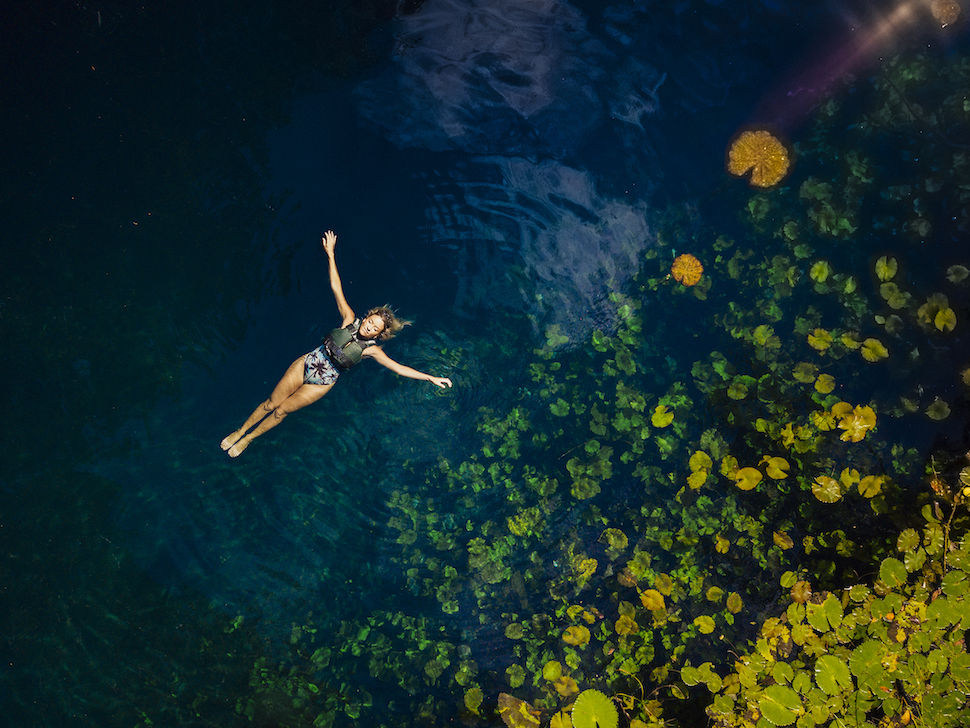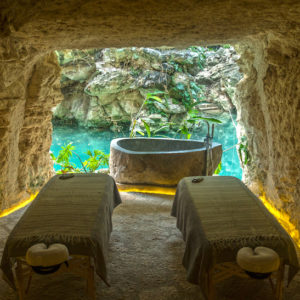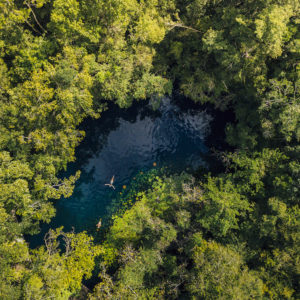
For centuries, cenotes were sacred to the Maya living on Mexico’s Yucatan Peninsula. The limestone sinkholes were thought to be the entrance to Xibalba, the Mayan underworld, and they provided lifesaving freshwater. Now, they draw tourists seeking wellness and adventure.
I get my first whiff of their allure deep inside a cave at Muluk Spa near Playa del Carmen, Mexico. I smell mint and rosemary as the massage therapist rubs a bundle of herbs down my exposed arms and legs. Then, surprisingly, I inhale the pungent odor of bamboo smoke.
“Feel the energy of the air and how it cleanses your heart,” she intones. “Breathe in the energy of the fire and feel how it purifies and transforms, opening new paths for your life.”
The aromas and her words—part of a Mayan cleansing ritual—help clear my mind and mentally prepare me for a full-body massage inside the underground treatment room. I’m used to clinical therapy rooms with white walls, so this one’s rough floors, rock walls, and earthy fragrances are new to me. But I soon learn that the setting is integral to the experience.
There are estimated to be over 7,000 cenotes dotting the Yucatan Peninsula . . .
Muluk Spa & Mayan Traditions

A treatment room overlooking a cenote river at Muluk Spa.
Located on the sprawling grounds of Hotel Xcaret Mexico, Muluk Spa is built adjacent to an ancient cenote river. Cushy day beds and hydrotherapy baths overlook turquoise water backed by cliff walls, and vines form curtains of privacy between the loungers, pools, and the natural setting. The spa also incorporates Mayan ingredients and traditions, like the ritual that kicked off my massage.
I emerge relaxed but oddly energized, and spa manager Pablo Velasco isn’t surprised. Residents of the Mayan Riviera know that these mythical pools and rivers offer a path to rejuvenation, and visiting a cenote spa isn’t the only way to tap into their wellness benefits.
The following day, I join a tour that visits four natural caves and sinkholes carved into the jungle’s limestone bedrock between Cancun and Playa del Carmen.
Cenote comes from the Mayan word D’zonot, which means “cavern with water.” There are estimated to be over 7,000 cenotes dotting the Yucatan Peninsula—the region is an exposed barrier reef; over millennia, erosion from rain, fresh water, and salt water has tunneled a system of underground rivers, caves, and open sinkholes (collapsed caves) into the soft rock.
“Mayans believed cenotes were gateways to the underworld,” explains Xenotes Tour guide Alberto Herrera. “They brought offerings of copper, clothing, and gold to help the departed cross over.”
They also relied on the clean, filtered pools for drinking water, he says.
Nature’s Hydrotherapy

Thousands of cenotes like this one are dotted around Mexico’s Yucatan Peninsula.
There is something meditative and almost spiritual about the placid sapphire and emerald circles of water sheltered in the forest. Some are completely exposed to the sun, their water green and algae-rich, with philodendron and montsera plants growing from cliff walls. Others are dark blue cisterns almost entirely underground, with bats dangling overhead and the roots of chicle (gum) trees growing greedily toward the water through the cave roof.
All of them require a literal leap of faith—or stairs, a slide, zipline or assisted rappel—to enter. Then, nature’s hydrotherapy takes over. I alternate between swimming in cold cenotes and heating up in the steamy jungle between plunges.
Touring cenotes is arguably more about adventure than self-actualization: our group swims in a canyon, snorkels into a cave, and kayaks down a cenote river. But between ziplines and cliff jumps, there are moments of reflection and quiet solitude.
At Lu’um cenote, I float on my back and stare up at the sunlight filtering through holes in a cave roof. I pause from paddling to watch blue morpho butterflies flutter by at another stop. And I kick past a lily pad forest, enjoying the seclusion inside the partially collapsed cave of Ha’ cenote.
On the van ride back to the resort, my limbs are jellied from the day’s activities and my mind is a clean slate. I feel every bit as cleansed and reinvigorated as I did after my massage the day prior. Like the Mayan equivalent of forest bathing, I’ve soaked and swam my way to wellness inside numerous natural cenotes.
Lisa Kadane
Lisa Kadane is an award-winning travel and lifestyle journalist based in Kelowna, B.C. Her articles have appeared in AARP, American Way, BBC Travel, Best Health, CNN Travel, enRoute, Today’s Parent, Postmedia newspapers, and many others. When not traveling, Lisa skis and hikes with her family, sips wine in the Okanagan Valley, and makes time for self-care.